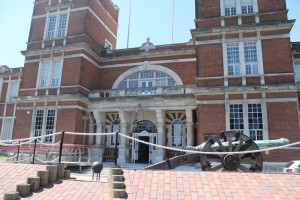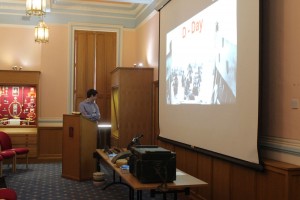Earlier today on the 70th anniversary of the D-Day landings, a lecture outlining the events of the ‘longest day’ was held in Gillingham, Kent.
James Scott, deputy curator of the Royal Engineers Museum and Library, delivered a general overview of the events that took place on the 6th June 1944 on the beaches of Normandy.
He outlined Allied failures that preceded D-Day and systematically went through the events of Operation Overlord- the code name for the Allied landings.
According to Scott, Adolf Hitler was aware of Overlord and even welcomed it; viewing it as an opportunity to crush their forces.
The 6th Airborne Division consisting of paratroopers and gilders made up the first phase of the operation by securing their drop zones on the beaches.Perhaps most famously, Pegasus Bridge was one of the main targets for Allied troops to capture.
Scott described the various German defences on the beaches and explained how the Allied forced were able to overcome them using Hobart’s funnies-a series of modified tanks.
One such tank was the Churchill AVRE (Armoured Vehicle Royal Engineers) with bobbin- essentially a tank attached with a roll of carpet to assist the tanks in navigating treacherous terrain. Another was the Churchill AVRE with flamethrower and in addition, rather ingeniously, the Churchill AVRE with Small Box Girder Bridge (SMG).
The Sherman Duplex Drive tank made it’s own way to Normandy unaided by landing craft. Whilst in water, the amphibious vehicle was designed to look like a civilian craft as it was partially submerged, only revealing the top section.
Operation Neptune- the navy landings on the beach- were explicated beach by beach. The landings encountered different failures and successes across five beaches on the Normandy coast.
The invasion was carried out by American troops, Canadian and British troops. American troops invaded Utah and Omaha beaches. Canadian troops took Juno beach, and the British took Gold and Sword beach.
Scott cites Omaha beach as having the most casualties with 2,400 as opposed to Gold beach, which only had 400 casualties.
Although the Allies fell short of securing their target area, 156,115 Allied troops succeeded in taking the beaches, which signalled the start of the Allied liberation of Europe.
Remembering the longest day- families from Gillingham
Deputy curator, James Scott said that “people gave their lives for something greater than themselves”
Library and Archive volunteer, Frank Clark, aged 61 used to be part of the military in the electrical mechanical engineers and says that “it’s very right and proper that we remember the sacrifices that were made”
Head Curator Rebecca Nash, aged 38, felt that the Royal Engineers played a pivotal role in the D-Day landings and had a great uncle in the 6th Airborne division, making today a highly personal event too.
The Royal Engineers Museum is currently running “D-Day and Beyond: an Online Exhibition” which is a collection of sketches and other material created by B. Haward, a Royal Engineer who was one of the Assault Squadrons during the Normandy Campaign.




